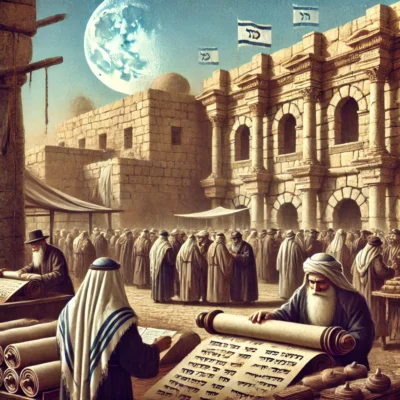The Jewish Calendar
by Beezone


he adoption and evolution of the Jewish calendar are complex and gradual processes that span centuries, with influences ranging from ancient Semitic traditions to the Babylonian exile. The roots of the Hebrew calendar stretch back to ancient times, with its early form based on lunar cycles, much like the calendars used by other Semitic peoples and the civilizations of Mesopotamia.
Early Foundations and the Exodus
As recorded in the Bible, a key moment in the development of the Hebrew calendar came during the Exodus. Before the Exodus, the Hebrews had likely used a lunar-based calendar similar to those of their Semitic ancestors, possibly influenced by Egyptian timekeeping during their time in Egypt. Despite exposure to the Egyptian solar calendar, the Hebrews maintained their distinct lunar traditions.
The formal adoption of a Hebrew liturgical calendar occurred when God instructed Moses to establish the spring month of Nisan (formerly known as Abib) as the beginning of the year, marking the Israelites’ departure from Egypt (Exodus 12:2). This pivotal moment defined the religious calendar for the Jewish people, with Nisan becoming the first month of the year. Festivals like Passover were aligned with the lunar cycle, as recorded in Leviticus (23:5). The civil New Year, Rosh Hashana, however, was observed in the autumn during the seventh month, Tishri (Leviticus 23:24), further emphasizing the calendar’s dual structure, where both the religious and civil calendars coexisted.
Influence of the Babylonian Exile
The Jewish calendar underwent significant changes during and after the Babylonian exile in the 6th century BCE. When the Jewish people were exiled to Babylon, they adopted many aspects of the Babylonian calendar, including the names of the months and the methods of calculating the lunar cycle. The Babylonian calendar was also lunar-based and featured intercalary months to keep the calendar in sync with the agricultural seasons, a practice that the Jews continued upon their return to Judea.
The Jewish calendar remained unfixed for almost 800 years, from the 5th century BCE to approximately the 3rd century CE, during the Second Temple period and beyond. New months were declared based on direct observation of the crescent moon, and adjustments, such as the addition of intercalary months, were made to ensure the calendar aligned with the agricultural year and religious festivals. However, the Jewish people still needed to have a fixed calendar system. During this time, religious authorities made decisions regarding intercalations in Jerusalem and, later, in Babylon.

The Fixed Calendar and the Work of Hillel II
It wasn’t until nearly 300 years after the destruction of the Second Temple, in the 4th century CE, that the Jewish calendar became fixed. Under the leadership of Hillel II, the calendar was standardized to ensure consistency, especially as Jewish communities were increasingly dispersed and could no longer rely on a centralized authority to declare new months based on lunar sightings. The new system incorporated mathematical calculations to determine the months and leap years, thus fixing the Jewish calendar as it is known today. This system ensured that festivals like Passover would always fall in the spring, aligning with the solar year while maintaining the lunar structure.
Conclusion
The Hebrew calendar has evolved over millennia, shaped by religious events such as the Exodus and historical experiences like the Babylonian exile. Initially based on lunar cycles and adapted from older Semitic and Mesopotamian systems, it was formalized with God’s instruction to Moses, who established the spring month of Nisan as the beginning of the religious year. Over the centuries, the calendar underwent further modifications, culminating in the fixed, calculated system introduced by Hillel II in the 4th century CE. This evolution reflects the Jewish people’s religious needs and historical circumstances as they sought to maintain their sacred traditions in an ever-changing world.
Read (study) more: